What We’re Reading: January 11th
 This week’s edition is guest edited by Arif Ashraf, a PhD student at Iwate University, Japan and Graduate Student Ambassador of ASPB (NOTE: Apply by January 15th to be an ASPB ambassador). His research interest is understanding the hormonal interplay in primary root development of Arabidopsis thaliana. He blogs about plant science (http://www.aribidopsis.com/). Arif is available in twitter (@aribidopsis) and Google plus (+Arif).
This week’s edition is guest edited by Arif Ashraf, a PhD student at Iwate University, Japan and Graduate Student Ambassador of ASPB (NOTE: Apply by January 15th to be an ASPB ambassador). His research interest is understanding the hormonal interplay in primary root development of Arabidopsis thaliana. He blogs about plant science (http://www.aribidopsis.com/). Arif is available in twitter (@aribidopsis) and Google plus (+Arif).
White paper. Arabidopsis bioinformatics resources: The current state, challenges, and priorities for the future
 Future research success demands that data are reliable, accessible and shareable. This means that as types and magnitudes of data change, best practices for how data are collected and stored must be regularly updated. Following a focused workshop, the International Arabidopsis Informatics Consortium has presented a vision for these best practices and how to implement them. Key recommendations include the need for standardization in both nomenclature and metadata, the development of a “Super-Portal” to link tools, resources and standards, and the need to continue developing tools that integrate across data types. They also point to the need to continue to engage with the broader community as well as scientists and data scientists and to highlight the interestingness and importance of plant research. (Summary by Mary Williams) Plant Direct 10.1002/pld3.109
Future research success demands that data are reliable, accessible and shareable. This means that as types and magnitudes of data change, best practices for how data are collected and stored must be regularly updated. Following a focused workshop, the International Arabidopsis Informatics Consortium has presented a vision for these best practices and how to implement them. Key recommendations include the need for standardization in both nomenclature and metadata, the development of a “Super-Portal” to link tools, resources and standards, and the need to continue developing tools that integrate across data types. They also point to the need to continue to engage with the broader community as well as scientists and data scientists and to highlight the interestingness and importance of plant research. (Summary by Mary Williams) Plant Direct 10.1002/pld3.109
Opinion: Capsaicinoids: Pungency beyond Capsicum
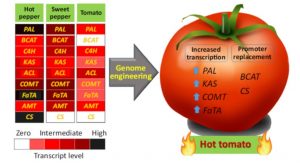 You probably saw this article being discussed in your favorite news channel (in the UK, coverage spanned from the Daily Mail to the Guardian). In an Opinion article, Naves et al. discuss the genetics, biochemistry, ecology and health-benefits of capsaicinoids (the “heat” in chili pepper), and consider the feasibility of increasing their production through engineering the biosynthetic pathway in tomato. Tomatoes and peppers are both in the Solanaceae family, and all of the genes involved in capsaicinoid production are present in the tomato genome, although with limited expression levels. Tomatoes though product much higher fruit yields, making them an attractive “biofactory” fruit for capsaicinoid production. This is a great paper to read with undergraduate students, as it is intriguing and accessible, and is likely to generate some heated discussions. (Summary by Mary Williams) Trends Plant Sci. 10.1016/j.tplants.2018.11.001
You probably saw this article being discussed in your favorite news channel (in the UK, coverage spanned from the Daily Mail to the Guardian). In an Opinion article, Naves et al. discuss the genetics, biochemistry, ecology and health-benefits of capsaicinoids (the “heat” in chili pepper), and consider the feasibility of increasing their production through engineering the biosynthetic pathway in tomato. Tomatoes and peppers are both in the Solanaceae family, and all of the genes involved in capsaicinoid production are present in the tomato genome, although with limited expression levels. Tomatoes though product much higher fruit yields, making them an attractive “biofactory” fruit for capsaicinoid production. This is a great paper to read with undergraduate students, as it is intriguing and accessible, and is likely to generate some heated discussions. (Summary by Mary Williams) Trends Plant Sci. 10.1016/j.tplants.2018.11.001
Genetics of rose petal fragrance: RhPAAS and 2-phenylethanol
 In Romeo and Juliet, Shakespeare wrote, “that which we call a rose, by any other word would smell as sweet,” but the truth is, most roses today don’t smell as sweet as the ones Shakespeare described; selection for prolonged cut flower life has largely been at the expense of fragrance. Roccia seek to redress this loss by exploring the genetic basis of rose fragrance. By examining a segregating population of two diploid rose cultivars, they identified several scent-associated loci including the PHENYLACETALDEHYDE SYNTHASE gene (RhPAAS), involved in the production of the volatile compound 2-phenylethanol. The allele correlated with the greater scent production is more highly expressed than corresponding alleles in less scented flowers. Interestingly the gene expression is highest early in flower development, before scent levels are elevated. The authors found that early in development 2-phenylethanol is conjugated and stored, and then released to provide fragrance in the mature flower. These data will be valuable as breeders work to restore rose’s sweet smell. (Summary by Mary Williams) Plant Physiol. 10.1104/pp.18.01468
In Romeo and Juliet, Shakespeare wrote, “that which we call a rose, by any other word would smell as sweet,” but the truth is, most roses today don’t smell as sweet as the ones Shakespeare described; selection for prolonged cut flower life has largely been at the expense of fragrance. Roccia seek to redress this loss by exploring the genetic basis of rose fragrance. By examining a segregating population of two diploid rose cultivars, they identified several scent-associated loci including the PHENYLACETALDEHYDE SYNTHASE gene (RhPAAS), involved in the production of the volatile compound 2-phenylethanol. The allele correlated with the greater scent production is more highly expressed than corresponding alleles in less scented flowers. Interestingly the gene expression is highest early in flower development, before scent levels are elevated. The authors found that early in development 2-phenylethanol is conjugated and stored, and then released to provide fragrance in the mature flower. These data will be valuable as breeders work to restore rose’s sweet smell. (Summary by Mary Williams) Plant Physiol. 10.1104/pp.18.01468
Hydrogen sulfide regulates energy production to delay leaf senescence induced by drought stress in Arabidopsis
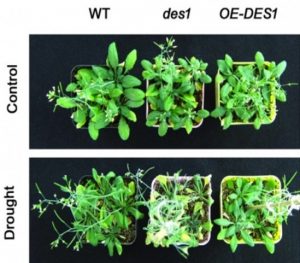 Premature leaf senescence can occur due to a mutation of a L-cysteine desulfhydrase1 (DES1) gene that encodes an enzyme that produces hydrogen sulfide (H2S), a “gasotransmitter” with functions in plants as well as mammals. Jin et al. explored the physiological functions of H2S in Arabidopsis. In addition to accelerated leaf senescsence and higher drought stress-sensitivity, des1 plants showed significantly downregulated expression levels of ATPβ-1, -2, and -3. Furthermore, older des1 leaves exhibited severely damaged mitochondria. Their results indicate that H2S delays leaf senescence in drought-exposed Arabidopsis by regulating energy production in mitochondria and protecting against cellular aging. (Summary by Naser A. Anjum) Front. Plant Sci. 10.3389/fpls.2018.01722
Premature leaf senescence can occur due to a mutation of a L-cysteine desulfhydrase1 (DES1) gene that encodes an enzyme that produces hydrogen sulfide (H2S), a “gasotransmitter” with functions in plants as well as mammals. Jin et al. explored the physiological functions of H2S in Arabidopsis. In addition to accelerated leaf senescsence and higher drought stress-sensitivity, des1 plants showed significantly downregulated expression levels of ATPβ-1, -2, and -3. Furthermore, older des1 leaves exhibited severely damaged mitochondria. Their results indicate that H2S delays leaf senescence in drought-exposed Arabidopsis by regulating energy production in mitochondria and protecting against cellular aging. (Summary by Naser A. Anjum) Front. Plant Sci. 10.3389/fpls.2018.01722
Local auxin biosynthesis is a key regulator of plant development ($)
 Morphogenic gradients of auxin are essential for plant phenotypic plasticity. Polar auxin transport plays a central role in auxin maxima generation. The exquisite spatiotemporal expression patterns of auxin biosynthesis genes suggested that local sources of auxin may contribute to the formation of auxin maxima. Brumos et al. addressed the role of local auxin biosynthesis in plant development by modifying auxin local production sites. Local auxin biosynthesis and transport act synergistically and are individually dispensable for root meristem maintenance. In contrast, flower fertility and root responses to stress require local auxin production that cannot be compensated for by transport in the establishment of auxin maxima. (Summary by Javier Brumos Fuentes) Developmental Cell: 10.1016/j.devcel.2018.09.022
Morphogenic gradients of auxin are essential for plant phenotypic plasticity. Polar auxin transport plays a central role in auxin maxima generation. The exquisite spatiotemporal expression patterns of auxin biosynthesis genes suggested that local sources of auxin may contribute to the formation of auxin maxima. Brumos et al. addressed the role of local auxin biosynthesis in plant development by modifying auxin local production sites. Local auxin biosynthesis and transport act synergistically and are individually dispensable for root meristem maintenance. In contrast, flower fertility and root responses to stress require local auxin production that cannot be compensated for by transport in the establishment of auxin maxima. (Summary by Javier Brumos Fuentes) Developmental Cell: 10.1016/j.devcel.2018.09.022
Interplay of the two ancient metabolites auxin and MEcPP regulates adaptive growth
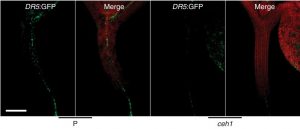 MEcPP, methylerythritol cyclophosphate, is an essential bifunctional plastidial metabolite that serves as a precursor of isoprenoids and is produced by the plastidial methylerythritol phosphate (MEP) pathway. Jiang et al. demonstrated that MEcPP controls adaptive growth by regulating auxin responses at transcriptional and post-transcriptional stages. They used the ceh1 (constitutively expression HPL) mutant, which accumulates MEcPP and has a stunted growth phenotype, along with inducible MEcPP-accumulating lines, and a combination of MEP pathway inhibitors to show the link with auxin homeostasis. ceh1 shows reduced hypocotyl length, lower level of endogenous auxin, and reduced expression of PIN1, YUC3 and YUC5. Taken together, this article establishes the interconnection between auxin and MEcPP from the molecular perspective. (Summary by Arif Ashraf) Nature Comms. 10.1038/s41467-018-04708-5
MEcPP, methylerythritol cyclophosphate, is an essential bifunctional plastidial metabolite that serves as a precursor of isoprenoids and is produced by the plastidial methylerythritol phosphate (MEP) pathway. Jiang et al. demonstrated that MEcPP controls adaptive growth by regulating auxin responses at transcriptional and post-transcriptional stages. They used the ceh1 (constitutively expression HPL) mutant, which accumulates MEcPP and has a stunted growth phenotype, along with inducible MEcPP-accumulating lines, and a combination of MEP pathway inhibitors to show the link with auxin homeostasis. ceh1 shows reduced hypocotyl length, lower level of endogenous auxin, and reduced expression of PIN1, YUC3 and YUC5. Taken together, this article establishes the interconnection between auxin and MEcPP from the molecular perspective. (Summary by Arif Ashraf) Nature Comms. 10.1038/s41467-018-04708-5
A regulatory module controlling stress-induced cell cycle arrest in Arabidopsis
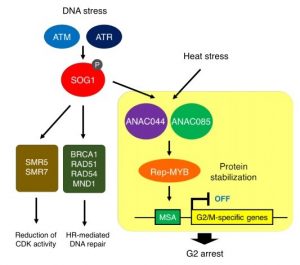 Progression of the cell cycle central to growth, but during stress conditions plants arrest cell cycle progression to enable the organism to survive. SUPPRESSOR OF GAMMA RESPONSE 1 (SOG1), a plant-specific NAC-type transcription factor, regulates the expression of almost all genes induced by double-strand breaks (DSBs) and consequently arrests the cell cycle in G2. Takahashi et al. recently identified 146 genes targeted by SOG1 and among them, two NAC transcription factors (ANAC044 and ANAC085) are close relatives of SOG1. Further evidence demonstrated that SOG1 directly induces ANAC044 and ANAC085 under DNA damage conditions and both anac044 and anac085 mutants are tolerant to DNA damage. In contrast, ANAC044 overexpression inhibits G2/M progression under DNA damage conditions. Furthermore, ANAC044 and ANAC085 control protein accumulation of the repressor-type MYB3R (R1R2R3-Myb). This work provides a comprehensive model where DNA damage and heat stress induce ANAC044 and ANAC085 to promote Rep-MYB accumulation, which repress a group of G2/M phase specific genes and consequently arrest G2. (Summary by Arif Ashraf) bioRxiv: 10.1101/495200
Progression of the cell cycle central to growth, but during stress conditions plants arrest cell cycle progression to enable the organism to survive. SUPPRESSOR OF GAMMA RESPONSE 1 (SOG1), a plant-specific NAC-type transcription factor, regulates the expression of almost all genes induced by double-strand breaks (DSBs) and consequently arrests the cell cycle in G2. Takahashi et al. recently identified 146 genes targeted by SOG1 and among them, two NAC transcription factors (ANAC044 and ANAC085) are close relatives of SOG1. Further evidence demonstrated that SOG1 directly induces ANAC044 and ANAC085 under DNA damage conditions and both anac044 and anac085 mutants are tolerant to DNA damage. In contrast, ANAC044 overexpression inhibits G2/M progression under DNA damage conditions. Furthermore, ANAC044 and ANAC085 control protein accumulation of the repressor-type MYB3R (R1R2R3-Myb). This work provides a comprehensive model where DNA damage and heat stress induce ANAC044 and ANAC085 to promote Rep-MYB accumulation, which repress a group of G2/M phase specific genes and consequently arrest G2. (Summary by Arif Ashraf) bioRxiv: 10.1101/495200
A Golgi-released subpopulation of the trans-Golgi network mediates protein secretion in Arabidopsis ($)
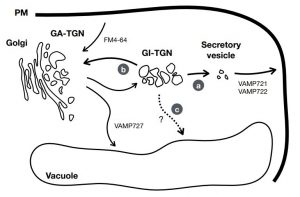 The plant trans-Golgi network (TGN) plays the role of early endosomes and acts as hub for the both secretory and vacuolar trafficking pathways. Two types of TGN, GA-TGN (Golgi-associated TGN) and GI-TGN (Golgi-released independent TGN), have been observed in plants. Here, Uemura et al. explore the cellular and physiological roles of GI-TGN. They show that GI-TGNs are involved in the protein secretory pathway and facilitate the transport of R-SNARE VAMP721 towards the plasma membrane, mediated via the SYP4-dependent secretory pathway that is also involved in extracellular defense against powdery mildew pathogens. Their model suggests that “the GA-TGN matures first into the GI-TGN and then into secretory vesicles by increasing the abundance of VAMP721-dependent secretory pathway components”. (Summary by Arif Ashraf) Plant Physiol. 10.1104/pp.18.01228
The plant trans-Golgi network (TGN) plays the role of early endosomes and acts as hub for the both secretory and vacuolar trafficking pathways. Two types of TGN, GA-TGN (Golgi-associated TGN) and GI-TGN (Golgi-released independent TGN), have been observed in plants. Here, Uemura et al. explore the cellular and physiological roles of GI-TGN. They show that GI-TGNs are involved in the protein secretory pathway and facilitate the transport of R-SNARE VAMP721 towards the plasma membrane, mediated via the SYP4-dependent secretory pathway that is also involved in extracellular defense against powdery mildew pathogens. Their model suggests that “the GA-TGN matures first into the GI-TGN and then into secretory vesicles by increasing the abundance of VAMP721-dependent secretory pathway components”. (Summary by Arif Ashraf) Plant Physiol. 10.1104/pp.18.01228
PID/WAG-mediated phosphorylation of PIN3 mediates polarity switches during gravitropism
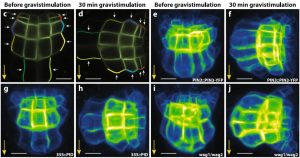 Auxin distribution depends on the polar localization of PIN-FORMED or PIN proteins. Based on different development and environmental stimuli, PIN proteins switch polarity to redirect the auxin flux. Additionally, phosphorylation of PIN is required for its function. For instance, PIN3 phosphorylation is required for PIN3 polarization and hypocotyl gravitropic response. Grones et al. showed that PID kinase is involved in the gravitropism and gravity-induced PIN3 relocation in root and hypocotyl. Downregulation of PID/WAGs increases gravity-induced PIN3 relocation and consequently gravitropic bending, whereas upregulation of PID reduces PIN3 relocation and bending. The authors introduced phosphomutant variants to the pin3-4 mutant and showed that these variants are not able to complement PIN3 function in root gravitropism. Overall, they presented a phosphorylation based polarity switch model for PIN3 in response to gravitropic stimuli. (Summary by Arif Ashraf) Scientific Reports 10.1038/s41598-018-28188-1
Auxin distribution depends on the polar localization of PIN-FORMED or PIN proteins. Based on different development and environmental stimuli, PIN proteins switch polarity to redirect the auxin flux. Additionally, phosphorylation of PIN is required for its function. For instance, PIN3 phosphorylation is required for PIN3 polarization and hypocotyl gravitropic response. Grones et al. showed that PID kinase is involved in the gravitropism and gravity-induced PIN3 relocation in root and hypocotyl. Downregulation of PID/WAGs increases gravity-induced PIN3 relocation and consequently gravitropic bending, whereas upregulation of PID reduces PIN3 relocation and bending. The authors introduced phosphomutant variants to the pin3-4 mutant and showed that these variants are not able to complement PIN3 function in root gravitropism. Overall, they presented a phosphorylation based polarity switch model for PIN3 in response to gravitropic stimuli. (Summary by Arif Ashraf) Scientific Reports 10.1038/s41598-018-28188-1
CONSTITUTIVE TRIPLE RESPONSE 1 and PIN2 coordinately regulate indeterminate root growth($)
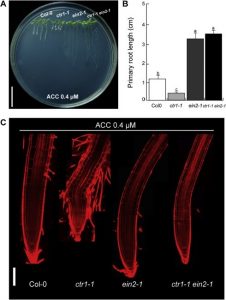 Méndez-Bravo et al. explored the mechanism for the dramatic phenotype of the ctr1 mutant (CONSTITUTIVE TRIPLE RESPONSE 1), which inhibits both cell division and elongation. In the ctr1-1 mutant background, auxin response is induced at the root tip and an increase in expression of the auxin transporter PIN2 is observed. The authors also found a decrease in the expression of the major stem cell maintenance genes PLETHORA1, SHORT ROOT, and SCARECROW. The defective root phenotype of ctr1-1 is restored in ctr1-1 ein2-1 double mutant, suggesting the importance of CTR1 and EIN2 for maintaining two major pathways, AUX-PIN-PLT and SCR-SHR, for proper root development. (Summary by Arif Ashraf) Plant Science: 10.1016/j.plantsci.2018.11.019
Méndez-Bravo et al. explored the mechanism for the dramatic phenotype of the ctr1 mutant (CONSTITUTIVE TRIPLE RESPONSE 1), which inhibits both cell division and elongation. In the ctr1-1 mutant background, auxin response is induced at the root tip and an increase in expression of the auxin transporter PIN2 is observed. The authors also found a decrease in the expression of the major stem cell maintenance genes PLETHORA1, SHORT ROOT, and SCARECROW. The defective root phenotype of ctr1-1 is restored in ctr1-1 ein2-1 double mutant, suggesting the importance of CTR1 and EIN2 for maintaining two major pathways, AUX-PIN-PLT and SCR-SHR, for proper root development. (Summary by Arif Ashraf) Plant Science: 10.1016/j.plantsci.2018.11.019
The secret of NIN (Nodule Inception) ($)
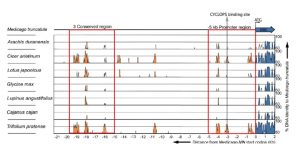 Twenty years ago, a genetic screen of Lotus japonicas identified NIN (NODULE INCEPTION), a transcription factor required for both early (infection thread) and late (nodule primordium development) stages of nodule formation. In daphne (a weak allele of NIN), infection threads form but not nodule primordia, suggesting that the NIN gene is only partially effective and that its two functions are separable. In this new work, Liu et al. figured out the mystery of NIN‘s regulation. They identified FN8113, another mutant in which infection thread formation and nodule formation are uncoupled; like daphne, FN8113 has a chromosome insertion several (4 – 7) kb upstream of the NIN start codon. Further analysis demonstrated that there are key transcriptional regulatory elements located far upstream of the start codon that are required for cytokinin-responsive NIN expression and nodule formation, and incorporation of these far-upstream regions allowed functional complementation of nin mutants. (Summary by Mary Williams) Plant Cell 10.1105/tpc.18.00478
Twenty years ago, a genetic screen of Lotus japonicas identified NIN (NODULE INCEPTION), a transcription factor required for both early (infection thread) and late (nodule primordium development) stages of nodule formation. In daphne (a weak allele of NIN), infection threads form but not nodule primordia, suggesting that the NIN gene is only partially effective and that its two functions are separable. In this new work, Liu et al. figured out the mystery of NIN‘s regulation. They identified FN8113, another mutant in which infection thread formation and nodule formation are uncoupled; like daphne, FN8113 has a chromosome insertion several (4 – 7) kb upstream of the NIN start codon. Further analysis demonstrated that there are key transcriptional regulatory elements located far upstream of the start codon that are required for cytokinin-responsive NIN expression and nodule formation, and incorporation of these far-upstream regions allowed functional complementation of nin mutants. (Summary by Mary Williams) Plant Cell 10.1105/tpc.18.00478



